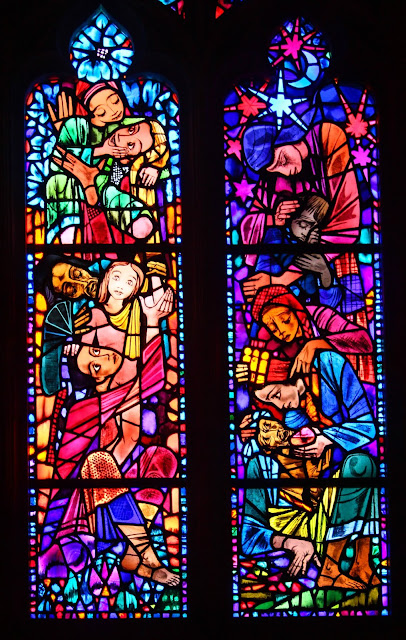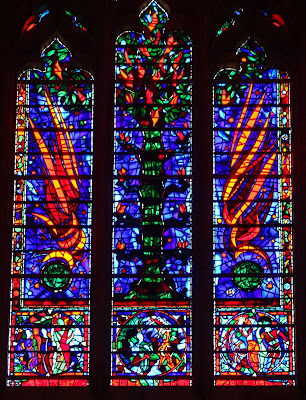On our recent visit to Washington, D.C. we visited the Washington National Cathedral and attended the longest of their three Sunday services, the 11:15 a.m. service in the Nave described as "the finest in high Cathedral tradition with rich musical offerings from the Cathedral Choirs, prayer, scripture, a sermon and Holy Communion." The service lasted about 75 minutes. It was a mother's day service and I was impressed to see two woman canons participate in the service, including one who gave a nice talk about her mother. It was my first Episcopal service.
 |
| The Washington National Cathedral, made of Indiana limestone. |
Because it is known as the "National Cathedral," I always assumed it was our nation's cathedral in some way. Perhaps a non-denominational church. So I was very confused in looking it up to find that it is an Episcopal Church. In fact it is the seat of the Presiding Bishop of the Episcopal Church and the seat of the Bishop of the Diocese of Washington. After the service I went up and asked one of the officials at the front why it is known as the national cathedral. He responded that it is the national cathedral of the Episcopal Church and that many events of a national nature are held there.
 |
| From near the entrance, looking forward toward the high altar. |
 |
| From the choir, looking toward the entrance. |

Wikipedia notes that the State funerals for three presidents have been held there: Dwight D. Eisenhower, Ronald Reagan and Gerald Ford. In addition, memorial services were held there for an additional five presidents: Harding, Taft, Coolidge, Truman and Nixon. Six presidents held prayer services there the day after their inaugurations: Theodore Roosevelt, Reagan, George H.W. Bush, George W. Bush (both terms), Obama (both terms) and Trump. Some other interesting services include: the funeral for Katharine Graham, publisher of the Washington Post; a memorial service for Neil Armstrong, the first man on the moon; the final Sunday sermon delivered by Martin Luther King, Jr. before he was assassinated; the funeral service of first lady, Edith Wilson; and a memorial for first lady Eleanor Roosevelt. In addition, President Woodrow Wilson is buried there along with his second wife, Edith Wilson. That is a pretty impressive list, although I would have guessed it would be even more impressive, after all, I thought it was our nation's church. The best explanation for the name, in my view, is its designation by Congress as the National House of Prayer.
 |
| President Woodrow Wilson is buried there. The only U.S. president buried in Washington, D.C., as is his second wife, Edith. |
 |
| This is apparently in honor of Dr. King's final speech here. |
 |
| I believe this is the Space Window, honoring the landing on the moon. At its center (see the round dot) is a fragment of a lunar rock given to the cathedral at its dedication service on July 21, 1974, the 5th anniversary of the Apollo 11 mission. |
The church is officially known as the Cathedral Church of Saint Peter and Saint Paul in the City and Diocese of Washington. It is the 6th largest cathedral in the world and the 2nd largest in the U.S. (after the
Cathedral of St. John the Divine in New York City), but drops down to 23rd, if just considering
churches, but still 2nd in the U.S. (the Basilica of the National Shrine of the Immaculate Conception in Washington, D.C. is two below it on the list). The foundation stone was laid in 1907 in the presence of President Theodore Roosevelt and the "final finial" was placed in 1990 in the presence of President George H.W. Bush.
 |
| I like the Jerusalem Cross, which is one large cross potent - a cross with crossbars at each of the four ends, filled in the crosses in each quadrant. |
 |
| Beautiful fabric for kneeling. |
 |
| I always love the burning candles. |
 |
| I also like the chairs set in rows. |
 |
| The stained glass was very different and fun. |
I was surprised to find memorials to Robert E. Lee and Stonewall Jackson inside, particularly since it was built many years after their time. These memorials may have been place in 1953 when the United Daughters of the Confederacy lobbied to install stained glass windows for them. In June 2016, the Confederate flags in those windows were removed (unfortunately, I did not get pictures of those windows).
My favorite part of the cathedral was underground, in the chapels beneath. I particularly liked the Chapel of St. Joseph of Arimathea, in a sunken chapel even below the regular floor of the basement. It had the feel of going down into a tomb. Helen Keller is interred just off that chapel.
 |
| Altar in the Chapel of St. Joseph of Arimathea. |
I also loved the Chapel of the Resurrection just across the basement hall. It is full of beautiful mosaics that were hard to get good photographs of because they sparkled so much.
 |
| Beautiful, beautiful mosaics. |
 |
| This one of Jesus and his disciples was my favorite, but the glitter made it difficult to photograph. |
 |
| I'm assuming this is Jesus with Mary Magdalene, shortly after his resurrection. |
 |
| The Bethlehem Chapel, also in the bowels of the cathedral. |
There are bits and pieces of the cathedral that I missed and may have to go back to see some day: the Darth Vader gargoyle on the outside; the ten stones from the
Chapel of Moses on Mt. Sinai set in the floor in front of the high altar, representing the ten commandments; and the stained glass windows featuring Stonewall Jackson and Robert E. Lee.






























So much history here, both represented and actual (in the cases of speeches and memorials). I think my favorite part was happening upon the marker for Helen Keller's burial site. I loved that it was written in both type and Braille.
ReplyDeleteI love the mosaics and the stain glass. A very interesting cathedral!
ReplyDeleteEdith Wilson is related to believe it or not, Thomas Jefferson!
ReplyDelete